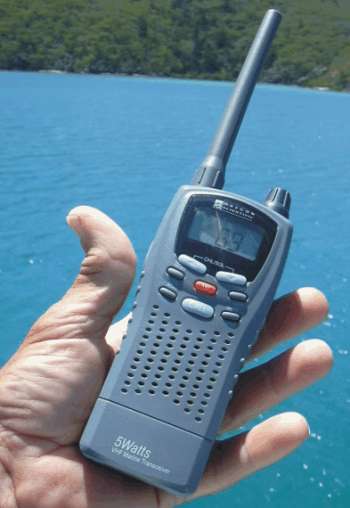|

We may be Dumb.... but we are FREE!
Home Page Back to technical articles
A new edition of The Coastal Passage has just been posted. Click on the image at right to download the PDF. Covid Cruising! From Tasmania to Greece with a boat built by the editor. For more information on this boat, see www.buildacat.com and check out The BareBones project. 
Geeez I felt Dumb! DUPLEX EXPLAINED:
What every VHF user should already know, but maybe you don't!

by Bob Norson
It was several years ago when I stumbled over the problem. I was testing a radio and couldn't work out why I wasn't getting all channels. The real shocker in retrospect was how many boaties were as dumb as me. Even the Australian distributer of the radio I was testing had no idea and instructed me to return the unit as defective! So for all you dummy's out there....
Here is what is going on......
Most of the frequencies on your VHF are "duplex". That means they receive and transmit on different frequencies even though they are on the same channel. This means that even if you are standing next to another radio, they can't hear your direct transmission if you are on a duplex channel, because you are transmitting on frequency "A" while they are receiving on frequency "B". This is where repeaters come in. Repeating stations do more than just boost a signal and send it on. They receive your frequency "A" and re-transmit your signal on frequency "B". Got that??...So, here's how it works: You are chatting with another boat at your island anchorage on channel 81 (duplex channel). Your transmit frequency cannot be heard directly by the other boat. The signal goes to a repeating station back on the mainland, which re-sends the message on a different frequency that your mate receives.
. Your personal conversation has travelled up to 80 miles back and forth, and any radio in range of the repeating station can hear it. If you want to talk directly to your mate, use a simplex channel. A handy tip to know if you are engaged in smuggling, gun running, or just don't want to clog up the repeater channels.
Oh yeah…Have you wondered what that control on your radio means? The one that says "USA" or "INT" (International)? What happened there is that the USA uses far less duplex channels. So…if you and your mate at the island anchorage both had your radios adjusted to the USA option, you could talk to each other on more channels directly. (This is just to illustrate a point, I am not recommending you use the usa channels)
To put it more simply, SIMPLEX frequencies are boat to boat.DUPLEX frequencies are boat to repeater to boat, even if the boats are next to each other.
Frank Stoove of Escondido was the first boaty I talked to after my radio test and subsequent enlightenment, that understood how this all works and it was he that recommended I reprint this brief article at least once a year... SO BLAME HIM!
Frequency chart for use in the USA Note that following the channel numbers below, you see numbers like '156.250' ... those are the actual frequencies used for that channel. When the two sets following a channel number are the same, that is a simplex freq. When they are different, that indicates that the receive and transmit are different frequencies, or a duplex channel.
Channel Number Ship Transmit MHz Ship Receive MHz Use
01A 156.050 156.050 Port Operations and Commercial, VTS. Available only in New Orleans / Lower Mississippi area.
05A 156.250 156.250 Port Operations or VTS in the Houston, New Orleans and Seattle areas.
06 156.300 156.300 Intership Safety
07A 156.350 156.350 Commercial
08 156.400 156.400 Commercial (Intership only)
09 156.450 156.450 Boater Calling. Commercial and Non-Commercial.
10 156.500 156.500 Commercial
11 156.550 156.550 Commercial. VTS in selected areas.
12 156.600 156.600 Port Operations. VTS in selected areas.
13 156.650 156.650 Intership Navigation Safety (Bridge-to-bridge). Ships >20m length maintain a listening watch on this channel in US waters.
14 156.700 156.700 Port Operations. VTS in selected areas.
15 -- 156.750 Environmental (Receive only). Used by Class C EPIRBs.
16 156.800 156.800 International Distress, Safety and Calling. Ships required to carry radio, USCG, and most coast stations maintain a listening watch on this channel.
17 156.850 156.850 State Control
18A 156.900 156.900 Commercial
19A 156.950 156.950 Commercial
20 157.000 161.600 Port Operations (duplex)
20A 157.000 157.000 Port Operations
21A 157.050 157.050 U.S. Coast Guard only
22A 157.100 157.100 Coast Guard Liaison and Maritime Safety Information Broadcasts. Broadcasts announced on channel 16.
23A 157.150 157.150 U.S. Coast Guard only
24 157.200 161.800 Public Correspondence (Marine Operator)
25 157.250 161.850 Public Correspondence (Marine Operator)
26 157.300 161.900 Public Correspondence (Marine Operator)
27 157.350 161.950 Public Correspondence (Marine Operator)
28 157.400 162.000 Public Correspondence (Marine Operator)
63A 156.175 156.175 Port Operations and Commercial, VTS. Available only in New Orleans / Lower Mississippi area.
65A 156.275 156.275 Port Operations
66A 156.325 156.325 Port Operations
67 156.375 156.375 Commercial. Used for Bridge-to-bridge communications in lower Mississippi River. Intership only.
68 156.425 156.425 Non-Commercial
69 156.475 156.475 Non-Commercial
70 156.525 156.525 Digital Selective Calling (voice communications not allowed)
71 156.575 156.575 Non-Commercial
72 156.625 156.625 Non-Commercial (Intership only)
73 156.675 156.675 Port Operations
74 156.725 156.725 Port Operations
77 156.875 156.875 Port Operations (Intership only)
78A 156.925 156.925 Non-Commercial
79A 156.975 156.975 Commercial. Non-Commercial in Great Lakes only
80A 157.025 157.025 Commercial. Non-Commercial in Great Lakes only
81A 157.075 157.075 U.S. Government only - Environmental protection operations.
82A 157.125 157.125 U.S. Government only
83A 157.175 157.175 U.S. Coast Guard only
84 157.225 161.825 Public Correspondence (Marine Operator)
85 157.275 161.875 Public Correspondence (Marine Operator)
86 157.325 161.925 Public Correspondence (Marine Operator)
AIS 1 161.975 161.975 Automatic Identification System (AIS)AIS 2 162.025 162.025 Automatic Identification System (AIS)
88A 157.425 157.425 Commercial, Intership only.
Frequency chart for use in the UK
Channel
designators Notes Transmitting frequencies
(MHz) Inter ship Port Operation
and ship movement Public
Correspondence
Ship Stations Coast Stations Single
frequency Two
frequency
60 156.025 160.625 X X
01 156.050 160.650 X X
61 156.075 160.675 X X
02 156.100 160.700 X X
62 156.125 160.725 X X
03 156.150 160.750 X X
63 156.175 160.775 X X
04 156.200 160.800 X X
64 156.225 160.825 X X
05 156.250 160.850 X X
65 156.275 160.875 X X
06 (1) 156.300 X
66 156.325 160.925 X X
07 156.350 160.950 X X
67 156.375 156.375 X X
08 156.400 X
68 156.425 156.425 X
09 156.450 156.450 X X
69 156.475 156.475 X X
10 156.500 156.500 X X
70 156.525 156.525 Exclusively for Digital Selective Calling for Distress,
Safety and Calling
11 156.550 156.550 X
71 156.575 156.575 X
12 156.600 156.600 X
72 156.625 X
13 (5) 156.650 156.650 X X
73 156.675 156.675 X X
14 156.700 156.700 X
74 156.725 156.725 X
15 (2) 156.750 156.750 X X
75 (4) 156.775 X
Channel
designators Notes Transmitting frequencies
(MHz) Inter ship Port Operation
and ship movement Public
Correspondence
Ship Stations Coast Stations Single
frequency Two
frequency
16 156.800 156.800 Distress,Safety and Calling
76 (4) 156.825 X
17 (2) 156.850 156.850 X X
77 156.875 X
18 156.900 156.900 X X X
78 156.925 161.525 X X
19 156.950 161.550 X X
79 156.975 161.575 X X
20 157.000 161.600 X X
80 157.025 161.625 X X
21 157.050 161.650 X X
81 157.075 161.675 X X
22 157.100 161.700 X X
82 157.125 161.725 X X X
23 157.150 161.750 X X
83 157.175 161.775 X X X
24 157.200 161.800 X X
84 157.225 161.825 X X X
25 157.250 161.850 X X
85 157.275 161.875 X X X
26 157.300 161.900 X X
86 157.325 161.925 X X X
27 157.350 161.950 X X
87 157.375
28 157.400 162.000 X X
88 157.425 X
AIS 1 (3) 161.975 161.975
AIS 2 (3) 162.025 162.025